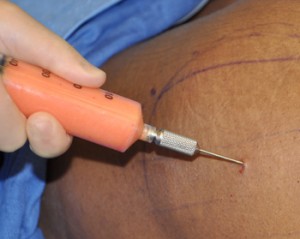
ALTERNATIVES
There are alternatives to fat grafting and they change based on the reason and the face or body site that needs more volume or contour. They could include synthetic injectable fillers, allogeneic (cadaver) and xenogeneic (animal) dermis, autogenous fascia and synthetic implants.
GOALS
The goal of fat grafting in every case is to either aesthetically add or restore lost or deficient soft tissue volume in the face or body. In some reconstructive procedures, the additional goal of fat grafting is to improve tissue quality and help prevent future wound healing problems.
LIMITATIONS
The limitations of fat grafting is based on several factors including the size and availability of fat from the donor site, how much volume the recipient site can take and, most importantly, how much fat survives after transplantation.
EXPECTED OUTCOME
Expected outcomes include the following: temporary swelling and bruising from the donor and recipient sites, temporary skin numbness from the donor and recipient sites, and months of healing and fat graft settling until the final result is seen in terms of permanent volume and contour. Healing of any fat grafting procedure is a process and the minimal amount of time to judge the result is three months and may take as long as six months to see the final retained volume and shape of the grafted face or body site(s).
RISKS
Significant complications from fat grafting are very rare but could include infection. More likely occurrences could include small nick-type scars from the harvest and injection of concentrated fat aspirates and a longer scar for the harvest and insertion of solid dermal-fat grafts. Additional risks include partial or complete loss of the fat graft, irregularities and asymmetries of the harvested and grafted areas, overcorrection vs. undercorrection of the treated areas and the unpredictability of fat grafting volume retention. While estimates are provided for percent of fat grafting survival based on Dr. Eppley’s experience, no guarantee can ever be made on how much fat will survive in any one patient. Any of these risks may require revisional surgery for improvement.
ADDITIONAL SURGERY
Should additional surgery be required to do additional fat grafting, perform contour adjustments or revise any harvest or graft insertion scars, these will generate additional costs.


